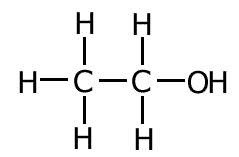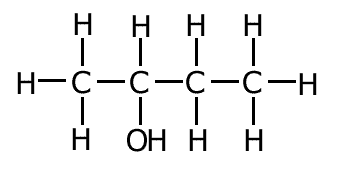How Do We Figure Out The Chemical Makeup Of Organic Substances
| Syllabus ref: 10.1 Representation of chemical formula in organic chemistry must leave the structure unambiguous. In that location are several accepted means to do this.
|
Empirical formula
The empirical formula is the simplest ratio of the atoms inside a molecule of the compound. Information technology emerges from calculations of formula using a consideration of the percentage limerick by mass of each element.
Traditionally, the method of determining the nature of a substance was based on a direct assay of the elements within the compound, taking advantage of the fact that most organic compounds are flammable. When burnt, all of the carbon turns to carbon dioxide and all of the hydrogen turns to water. Thus, if the mass of carbon dioxide produced from a known mass of an unknown compound is institute, the actual mass of carbon and hence the percentage carbon in the original compound can be calculated.
Example: 5g of an unknown organic compound produced 11.0g of carbon dioxide on complete combustion in excess air. Calculate the percent carbon in the compound.
11.0g of carbon dioxide, formula CO2, relative mass = 44
∴ 11.0g contains 12/44 x 11.0g of carbon = 3.0g
Percentage carbon in the unknown compound = 3/5 x 100 = 40.0% carbon
The same procedure tin exist applied to the hydrogen in an organic compound as it all turns to water.
Example: 5g of an unknown organic chemical compound produced 3.3g of water on complete combustion in excess air. Calculate the percentage carbon in the chemical compound.
3.3g of h2o, formula HiiO, relative mass = 18
∴ 3.3g contains 2/18 x iii.3g of carbon = iii.35g
Pct carbon in the unknown compound = 0.37/five x 100 = vi.7% hydrogen
![]() peak
peak
Molecular formula
The molecular formula shows the actual number of atoms of each blazon in the molecule. For example, the molecular formula of ethanol is C2HviO.
There are two key bug with using the molecular formulae to represent molecules:
- They requite no indication equally to the bodily arrangement of the atoms within the molecule.
- In that location may exist many different molecules with the same molecular formula.
However, in analysis the molecular formula is a good start when working out the identity of a compound. A loftier definition Mass Spectrometer tin can determine the relative formula mass of a compound to such a loftier degree of accuracy that the molecular formula tin be obtained direct. It is then up to other techniques to identify the actual arrangement of the atoms within the molecule.
![]() top
top
Structural formula
The structural formula shows the actual organization of the atoms in a molecule by drawing the bonds as lines between messages representing the atoms. A unmarried bond is show equally i line just and a double bond is shown as a double line.
In this example in that location is rarely whatever issues of ambiguity when representing molecules. Consequently the structural formula is the representation of choice in almost cases.
Example: The structural formula of ethanol CtwoHsixO is represented as follows:

![]() tiptop
tiptop
Condensed formula
The condensed formula is a shorthand method of representing the structural formula which relies on some knowledge of chemic structures. The structure is written starting at one end of the chain with each carbon shown along with any attachments. There are no single bonds shown betwixt carbon atoms, as it is assumed that the reader understands that the atoms must be joined together in the chain, using at to the lowest degree one bail.
Ethanol is represented as CHiiiCH2OH. Reading from left to right this says:
- Carbon number one is attached to iii hydrogen atoms.... then joined to carbon number 2, which
- has two hydrogen atoms attached and is joined in turn to...
- an oxygen atom which also has one hydrogen attached.

Where groups are attached to the carbons in the chain they tin can be show by using brackets immediately after the carbon to which they are attached.
Instance: CH3CH(OH)CH2CH3
In this case there is an -OH group fastened to carbon number ii in the chain.

Don't forget that carbon always forms 4 bonds. This can help when cartoon a construction. If you end up with a carbons with 3 or five bonds then you have washed it wrong!
![]() height
height
Skeletal formula
This is another style to correspond the molecular structure. In a skeletal formula each carbon is represented by an bending, or termination in a line and the hydrogen atoms are simply assumed. Double bonds are shown every bit a double line and hetero atoms are draw every bit usual. A certain amount of logical reasoning must exist used to empathise the structure from a skeletal representation.
| butane | trans-but-2-ene | benzene |
| | | |
| | | |
This type of representation is very useful when the molecule is large and the number of atoms becomes likewise unwieldy for other representations.
NOTE The IBO will NOT accept skeletal formula to stand for structures. If you are asked for a construction you MUST testify all of the atoms.
![]() top
top
Lewis structures
These are structural formula in which the bonds are non represented by lines, but rather by the electron pairs that brand up the bonds. Any solitary (non-bonding) electron pairs must likewise be shown. The electron pairs may be shown as 2 dots, or 2 crosses, or even a line.
Instance: The Lewis structure of ethanol CtwoHsixO is represented as follows:

Notice that the ii lone pairs on the oxygen are besides shown.
When drawing Lewis structures there are most always eight electrons around each atom (except hydrogen). In that location are some exceptions, but not in organic chemistry.

![]() top
top
Source: https://www.ibchem.com/IB16/10.12.htm
Posted by: velezhavenou.blogspot.com




.gif)
.gif)
.gif)
0 Response to "How Do We Figure Out The Chemical Makeup Of Organic Substances"
Post a Comment